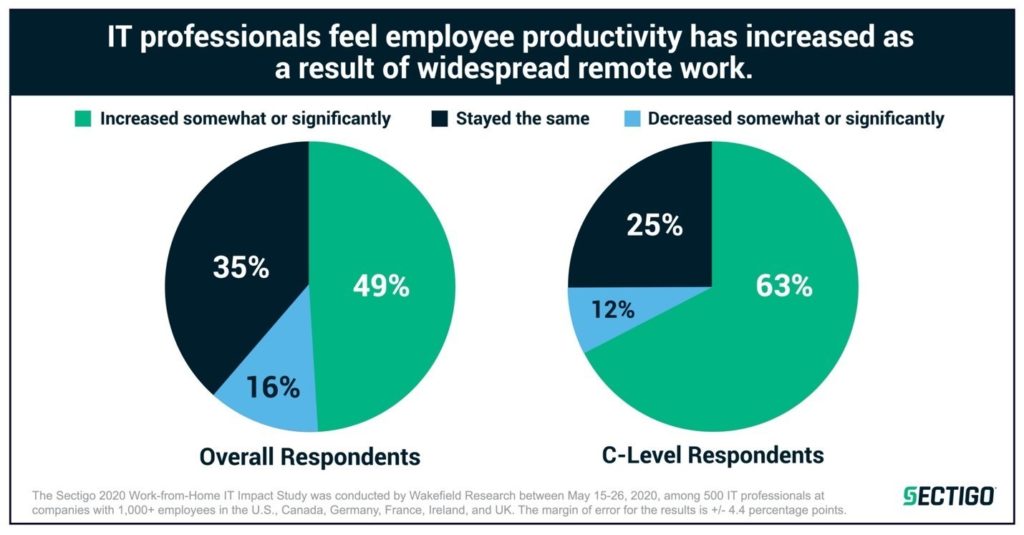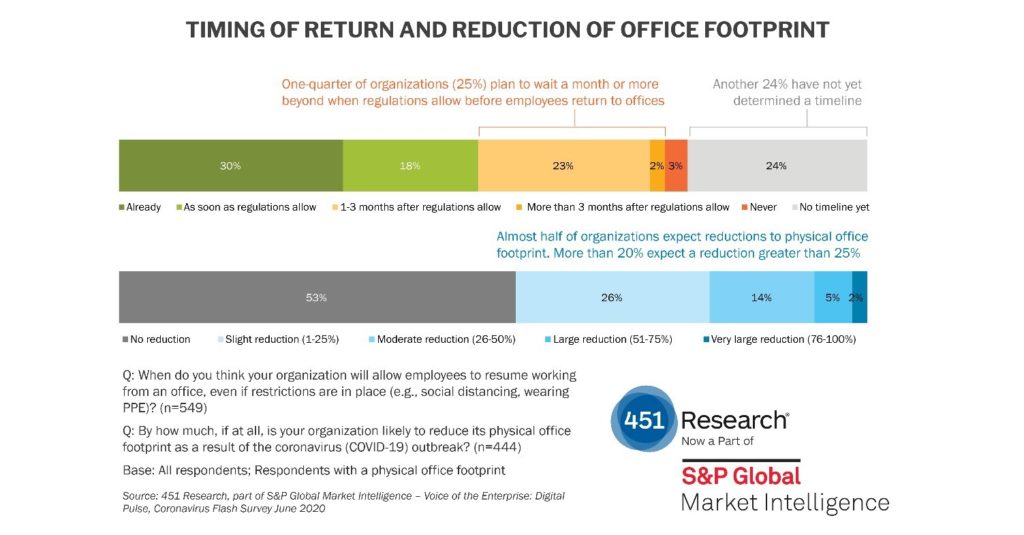The pandemic has radically altered the way most enterprises conduct business. For companies that have integrated remote work into daily operations, this trend will continue to impact the future of work. Here are some study findings:
Nearly 40% of Companies Delayed Revenue-Generating Initiatives for 1 Month or Longer When Lockdown Began
March 2020 saw the beginning of worldwide lockdown measures that forced most businesses worldwide to work remotely in response to COVID-19. Organizations quickly pivoted their operations from office environments to work-from-home (WFH) models, significantly impacting productivity, performance and security. These are among the findings of the “2020 Work-from-Home IT Impact Study,” which cybersecurity provider Sectigo commissioned and conducted by independent research firm Wakefield Research, which polled 500 IT professionals at companies with at least 1,000 employees in the U.S., Canada, Germany, France, Ireland and UK, to understand the impact of the worldwide crisis on large businesses.

Transforming to a fully remote work environment required quick updates to technology, processes and procedures, resulting in repercussions to revenue and cybersecurity. However, the survey revealed that despite the need to adapt to a rapidly changing work environment, IT professionals report that their organizations saw performance improvements. In fact, almost half of respondents (49%) report that employee productivity at their company has increased as a result of widespread WFH measures.
Study Shows 94% of Respondents Want to Continue Working Remotely
 A new study released by RW3 CultureWizard reveals a fundamental change in the way we work. Nearly 2,700 business professionals from 106 countries who participated in the biennial study, 2020 Global Virtual Work Survey, indicated a strong preference for continuing to work remotely, even when they have an option to return to the workplace.
A new study released by RW3 CultureWizard reveals a fundamental change in the way we work. Nearly 2,700 business professionals from 106 countries who participated in the biennial study, 2020 Global Virtual Work Survey, indicated a strong preference for continuing to work remotely, even when they have an option to return to the workplace.
A total of 89% of respondents say their virtual teamwork is somewhat or extremely critical to productivity. The study also indicates that 65% report virtual communication is more difficult than in-person communication, and 54% of respondents need to adjust their communication because of the lack of visual contact.
Findings show the virtual nature of remote work can exacerbate differences in individual work styles and culture, underscoring a pressing need to develop virtual collaboration and leadership skills. For instance, 92% of respondents reported engagement and collaboration as traits of a good virtual teammate, but different cultures have different understandings of what it means to collaborate.
Given the significance and challenges of virtual work, it’s noteworthy that only 26% are trained to increase their productivity on these teams.
COVID-19 Shakes Up the Future of Work
Global enterprises are quickly learning how to adapt to the disruptions from COVID-19, according to a recent survey conducted by 451 Research, the emerging technology research unit of S&P Global Market Intelligence. Close to 80% of organizations surveyed said they have implemented or expanded universal work-from-home policies as a result of COVID-19, and 67% expect these policies to remain in place either permanently or for the long-term.

The 451 Research’s Digital Pulse COVID-19 Flash Survey features responses collected between May 29 to June 11, 2020, from approximately 575 IT decision-makers across a range of industries. The new study sheds light on the future of work and highlights some of the enterprise-wide changes that companies actually experienced or implemented. Topics covered include operational impacts, changes to budgets, spending and pricing, adaptation of IT initiatives, and new findings on how enterprises plan to return to the office.
Highlights from the survey include:
- Firms have implemented several travel and event-related measures that change office life. In addition to the 80% of organizations that said they have employed expanded or universal work-from-home policies, 85% have implemented travel limitations and the same percentage limited or banned face-to-face meetings. In addition, 71% of respondents said they are converting hosted events into virtual ones, and 37% have expanded employee leave rules among other changes.
- Companies are in no rush to head back to workplaces. Although close to 19% of organizations intend to have employees return to offices as soon as local regulations allow, 25% will wait a month or more. Another 24% have not yet determined any timeline.
- A reduction in office space is expected. Although companies are hesitating to head back to physical office spaces, 47% of respondents say they are likely to reduce its physical office footprint because of the COVID-19 outbreak. More than 20% expect it to reduce by more than 25%.
- Altered working conditions are presumed to be long-term or permanent. About 20% of respondents say their organization is planning to operate under alternate conditions such as remote working, wearing protective gear and social distancing through 2021 and beyond. In addition, 14% responded that conditions have been altered permanently, and 18% have yet to establish a plan.
- Travel will remain scarce, even in Q4 2020. Compared with the last quarter of 2019, a third of organizations (34%) expect work travel to be reduced by 80% or more in the fourth quarter of this year. A large cohort of respondents (21%) say they don’t know how much travel will resume during this period.
- Social distancing serves as a barrier to returning to office life. Study findings indicated that 79% of organizations agree that social distancing will be the biggest challenge in resuming normal operations.
- Organizations are more likely to be spending more on IT resources with notable increases to security spending. Compared with March, increased information security spending grew more common (from 15% to 28% of businesses). Organizations are spending more on communication and collaboration technologies (50%), employee devices and services (43%), information security tools (42%) and network capacity (38%).
- Many businesses are seeking flexible terms from suppliers. More than half (56%) of organizations agreed they were offering to adjust the terms of leases, licenses or contracts for their customers. Similarly, 42% of organizations said they were expecting or asking IT vendors to adjust pricing, payment terms or payment models.

